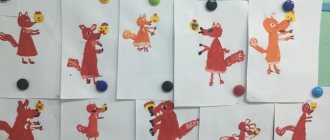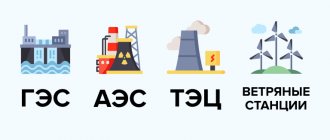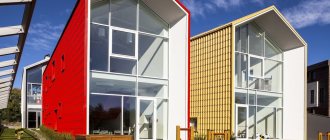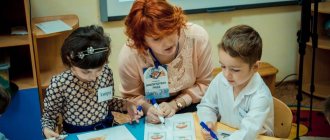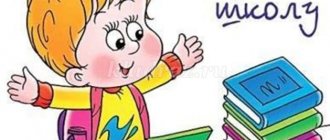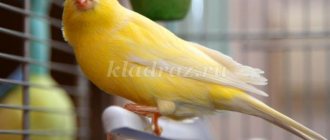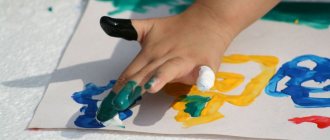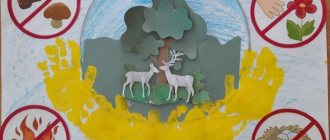Elena Vakhrushina
Summary of the lesson series “Introduction to the basics of geometry for children aged 5–7 years”
Abstract
series of classes
«Introduction to the basics of geometry for children aged 5-7 years»
Explanatory note
Since ancient times, people have needed to mark out plots of land for fields, roads, and buildings. geometry was born , which translated from Greek means land surveying. Without knowledge of geometry it is impossible to build houses, dachas, create cars, furniture, clothes, toys and much more.
This series of lessons will allow
— introduce preschoolers aged 5-7 years to the basic concepts of geometry on a plane and in space,
- to form geometric and logical thinking,
— activate creative thinking, encourage the search for non-standard solutions to complex mathematical problems,
- develop attentiveness and the habit of prolonged mental work.
The proposed tasks can be used as part of a lesson on FEMP .
Topic 1: “Point. Line"
.
Materials:
Owl and Owl are toys;
Multimedia projector;
For each child: individual notebook, ruler;
On each table: a set of colored pencils, felt-tip pens, automatic pens.
Progress of the lesson:
Educator: Last time I told you a fairy tale about the Owl, about Mother Owl and about the country of Geometry . And what happened next, the next day?
Mom Owl was busy with her business in the kitchen, and the impatient Owl went to the country of Geometry alone . And, of course, I got lost. Here he met one very curious Point.
She also wanted to know everything. He will see unfamiliar line and will certainly ask (slide No. 5)
: “What is this line called?
(Straight or curved? Long or short) (
Children's ) .
And they went on a journey together.
They walked together in a straight line. They walked and walked, they were tired. They stopped and said: “How long will we continue to walk? Is the end of the line soon?
What will you answer them guys?
Children: “Without end, without edge -
The line is straight.
Walk along it for at least a hundred years
You won’t find the end of the road.”
Educator: Dot and Owl were sad: “What should we do? So go on forever?
.
Then scissors appeared, snapped right in front of my nose and cut a straight line on one side, and then on the other.
"How interesting!"
- Dot and Owl exclaimed. - What happened to our line? On one side there is an end, on the other side there is an end. How does is called?"
"This is a cut"
“,” said the Scissors, “you can cut many pieces and even different lengths: some short, others long.”
Assignment: Guys, take scissors and make a piece from a strip of paper.
Educator: Pick up what you got.
Educator: A segment is a part of a straight line that is bounded on two sides.
Slide No. 6
Educator: Who can tell us how a straight line differs from a segment? (does the line have ends, how many ends does the segment have)
.
Educator: The scissors scattered the pieces everywhere.
And Dot drew a circle, and it turned out to be a sun with different rays.
Guys, each of you has a set of sticks - segments. What can you make out of them? (independent work, review and discussion of the completed task).
Educator: At this time, Dot was still playing with the segments, then she asked the Scissors how you can determine which of the segments is the longest and which is the shortest?
What do you think the Scissors responded? ( children’s , independent work comparing segments of different lengths).
Conclusion: Lines can be measured by applying or superimposing on each other.
Topic 3: “Variety of lines and segments”
.
Material: Owl and Dot - toys;
Multimedia projector;
For each child: album sheet, scissors.
For each table: a set of colored pencils, felt-tip pens, automatic pens, paint brushes of different sizes, gouache, woolen threads, strips of colored paper, PVA glue, wet wipes, etc.
Fun geometry for preschoolers
You can and should do math with your child in preschool age. Mathematics for kids is not only about numbers and counting. This is also the basics of geometry.
Entertaining geometry for preschoolers will help in a fun way, through games, fairy tales and interesting tasks, to introduce the child to geometric figures and methods of measuring them, lay the foundation for spatial thinking and give ideas about design.
Geometric tales
Geometric tales, as a variation of the broader concept of “mathematical tales,” are interesting stories with a fairy-tale plot in which geometric figures act as characters or serve as scenery against which the story unfolds.
Geometric fairy tales for preschoolers are an important element in the system of activities that develop mathematical literacy:
- they teach the child to reason and justify his opinion;
- help determine cause-and-effect relationships;
- deepen understanding of geometric shapes;
- develop skills in solving mathematical problems;
- form logical thinking.
ADVICE FOR PARENTS: given that children have a predominance of visual-figurative thinking, when choosing or composing a geometric fairy tale, take care of visual material: these can be plot pictures based on the content of the story, figures cut out of cardboard, complex decorations that will turn the fairy tale into an entire theatrical production .
"Three Comrades"
Far, far away, in the country of Geometry in the magical Figured City, two friends lived in a square house with a triangular roof and round windows: the merry fellow Krug and the daredevil Triangle.
The circle was smooth and rosy, even and fine. He has no corner, no crookedness. Just know, he rolls along the path and sings funny songs. And the triangle - that guy is a little prickly. Of course, there are three whole angles in the figure, no joke. But he was not afraid of anything or anyone. Just a little bit - he puts his sharp corner forward and is ready to stand up for himself and protect his round friend from danger. So they lived, drank tea with round buns and went for walks in the triangular clearing in the forest.
And then one day they go for a walk. Suddenly, out of nowhere, a stranger runs out onto the path. The circle immediately stopped its song and rolled off behind the triangle. Not that he was scared, of course, but it would be more reliable this way. And the triangle bristled, put its hands on its sides, and asked the stranger a little menacingly:
- Wait, good fellow, who are you?
“I am the Square Acrobat,” answers the stranger. - Don’t be afraid of me and don’t be angry. I am good-looking, kind and cheerful. All my sides are equal, all 4 corners are the same. I'm all neat and cute. I come from the Quadrangular city of our country Geometry. I have many friends there: Diamond, Trapezium, Rectangle, and the main one in our city is Mr. Parallelogram. But no matter where you look, everyone has 4 corners. So I decided to wander around the world, to see who is where and who lives how. Will you take me as your friend?
Then the circle rolled out from behind the triangle and joyfully exclaimed:
- Why not take it, brother Kvadrat. Let's be friends together. Three's more fun!
And since then, the three of them often met in a triangular clearing: Circle the merry fellow, Triangle the daredevil and Square the acrobat. And different adventures happened to them, but that’s another story. In the meantime - THE END!
Fairy tale tasks:
- Answer the questions:
- What country did your friends live in?
- Which cities of the country Geometry are described in the fairy tale? Come up with suitable names for other cities in this country.
- Name what character traits the Circle and the Triangle possessed.
- Why did the Circle and Triangle become friends with the Square?
- What are the names of Square's friends from the Quadrangle City?
- What are the names of your friends? Why are you friends with them? What personality traits of your friends do you value most?
- Make a beautiful house for your fairy-tale friends.
For kids 2–3 years old, prepare the figures for appliqué in advance. Older children can be asked to cut out the blocks for the house themselves.
- Draw a picture for the fairy tale.
Geometric physical education minute
When drawing up a plan for developmental activities with a preschooler, do not forget how important it is to periodically change the type of activity and be sure to include outdoor games and exercises in intellectual tasks.
Physical education solves important problems:
- relieves tension and fatigue;
- provides emotional release;
- strengthens general motor skills;
- develops coordination of motor and speech activity;
- speeds up the thought process.
To make your warm-up useful, educational, and fun, choose your child’s favorite songs as the musical accompaniment, and a previously studied topic as the text.
"Ears on top of your head"
For the game, prepare two cardboard figures. For example, a square and a circle. Announce: “You must look at me carefully and listen to me carefully. If I speak and show the same figure, then you clap your hands. If I name one and show you another, you jump on the spot.”
After that, you turn on the music and start playing. At first it will be difficult for the child, so give him time to think, and until he decides which action will be correct, let him hold his hands on his belt and do light body swings (or shallow squats) in different directions to the music.
"Circles and circles"
A round dance game designed for a group of children. But at home, you can walk in a circle and perform playful movements together with your baby.
Show me, my friend (let's walk in a circle to the music)
Here is such a huge circle (we stop, stand on tiptoes, reach up with our arms bent at the elbows (show a big circle)),
Show me, my friend (we walk in a circle to the music)
The smallest circle (we squat and stretch out our hands in front of us with our index and thumb closed).
"Catch the Figure"
Place several chairs around the perimeter of the study room with the backs facing the center of the room. Attach large cards with different shapes to the back. Explain the task to your child.
While the music is playing, you dance in the center of the room, and the figures admire you, but as soon as the music stops, one of the figures will try to escape, and we must hold it. I will help you: keep an eye on the figures and tell you which one is trying to sneak away from us. And you must quickly run up and detain the fugitive.
If you attach several repeating shapes of different colors, you can complicate the task by adding a definition of the desired object using two properties.
You can agree that the baby not only dances freely to the music, but follows your verbal commands:
- walks in circles with high knees;
- crouches;
- jumps;
- spinning in place
etc.
Geometric games
Stock up on cards with geometric shapes of different colors in advance. Use them to reinforce your ability to recognize shapes using familiar games:
- lotto;
- domino;
- “find the odd one out”;
- "what changed";
- "find a pair."
Use different object properties:
- form;
- color;
- size.
For example, for the “Find the odd one out” exercise, you can offer your child the following drawing:
Look at it carefully. Ask your child a few questions:
- How many columns are there in the picture?
- How many lines are there in the picture?
- How many figures are there in each line?
- Tell me all the figures you see.
- How many {red | blue | green} pieces?
- How many {circles | squares | triangles | polygons}?
- Cross out the extra figure on each line. Explain your choice.
Friends, use your pedagogical imagination, experiment and get real pleasure from working with your child, and then your efforts will certainly yield positive results.
May your parenting be happy! See you again!
Progress of the lesson:
Educator: Today we will travel again with our old friends Dot and Owlet . So, what can we call all of us? (travelers)
. And those who travel a lot often take pictures of beautiful corners of the globe.
Look at what pictures our friends : slide No. 7, 8 (change pictures by clicking)
.
Assignment: looking at the pictures - what is shown, what lines are in width, directions, straight or winding, etc. Are there any segments? What are they?
Educator: The nature of our globe is very diverse, it needs to be protected so that other generations can see this beauty.
And lines and segments can be seen not only in nature, but also in our room.
Task: find vertical lines, horizontal, inclined, wide, narrow, etc.
Educator: Well done, you are very attentive! Now try to draw on your sheet of paper using different lines and segments (independent work, looking at, discussing the drawings)
.
Topic 4: " Introducing Angles "
.
Material: Owl and Dot - toys;
Multimedia projector;
For each child: drawing of a city from geometric shapes , a set of colored pencils.
Progress of the lesson:
Educator: Guys, today we will continue our journey through the country of Geometry . And our friends Owl and Tochka have not met yet today. Let's bring them here in cars.
The situation is played out: one car is carrying the Owl, the other is carrying the Dot (corresponding movements of the children )
. Friends meet at one point, say hello, children sit at tables, see Slide No. 9.
Educator: Look, these are 2 roads along which our cars drove. At one point the roads intersected and a corner was formed.
And Owl offers to find in our group where the corners are hidden? (independent work)
.
Educator: Well done, guys, now look at the pictures on your tables, this is an assignment for you from Mother Owl. She wants you to carefully examine the drawings, find all the angles, geometric shapes , carefully color everything you see, and then we will talk (independent work)
.
Educator: So, you all coped with this task, well done. Who guessed the name of this city that is depicted in your drawings? (city of Geometry )
.
Topic 5: “ Getting to Know the Circle ”
.
Material: Dot – toy;
For each child: a set of geometric shapes , an individual notebook, a set of colored pencils, a ruler.
Multimedia projector.
On each table: a set of round objects.
Learning geometric shapes with kids in preschool educational institutions
When studying geometric concepts, children also gain other knowledge and skills in parallel:
- they learn to think logically;
- get the opportunity to develop knowledge of the Russian language;
- the perception of space and the ability to navigate in it improves;
- children develop fine motor skills;
- Intellectual qualities develop: the ability to make comparisons, analyze, and generalize.
Note! When teaching in kindergarten, the development of geometric concepts is not highlighted as a separate topic, but occurs in combination with other topics.
Children learn geometry
Learning colors and shapes for children from 2 years old
Geometry learning should begin with the simplest figures; more complex ones should be left for subsequent years. It is believed that children are able to perceive shape on a subconscious level within six months after birth. At this time, the main way of teaching is through mention during the story. When showing pictures, you can casually notice that the objects depicted have a certain shape.
When teaching, you need to take into account that kids can only learn to distinguish between the simplest ones: circle, square and triangle.
Note! Studying in a year or two or three should be easy and fun. For mastering it is convenient to use three-dimensional figures. Studying, for example, a circle, you can imagine that he came to visit the baby. You can use your child's finger to trace a circle along the outline. You can make such an applique, decorating it with eyes and a nose.
Drawing classes in secondary groups of preschool educational institutions on the theme “Spring”
A child can play with this item: make a tower by placing one on top of the other, throw it to the side or put it in a box.
This integrated approach to a geometric design project is very effective for toddlers, but for younger children it can be considered the primary way to learn shapes.
For children under two years of age, the following may be used:
- children's ability to compare objects;
- use a children's educational set, where you need to select a hole of a suitable shape and size for the figurine.
A two-year-old child is able to choose the appropriate shape from a set.
When they teach figures to 3-year-old children, they can already show the one that was named by the teacher.
Learning figures for children 3 years old
When teaching children geometric shapes, it is important to consolidate familiarity with the material that they have previously learned. We need to continue studying and move on to those that are more difficult to understand - oval, rhombus and rectangle.
When teaching children, you can show children examples of figures, letters of the alphabet and compare them with other objects in shape and size.
Important! During the walk, children are told about the objects they see, mentioning their shape and simple geometric properties.
An important role when teaching geometric shapes to children is played by creative activities, when children draw or sculpt samples and put them together from a given set of component parts.
Using cards depicting complex objects, the child is asked to talk about the components in the form of certain shapes.
Children education poster
Geometric shapes in the senior group
At this time, the lessons move on to considering new, more difficult to understand figures, repeating those that they should have known before.
In classes at the age of five, children are asked to consider and talk about their common and different properties. For example, questions are asked about where open figures have corners and in which cases they do not.
They try to teach children to analyze the complex shapes of real objects, to find elements in them that have the form of simple figures. They learn about more complex shapes, such as a cone.
Geometric shapes in the preparatory group
At this age, children have already mastered the basics of understanding the shapes of objects. At this stage, it is important to develop knowledge and make it more systematic. At this age, children develop a foundation for schooling.
Note! Children in the preparatory group, when introduced to polygons, are told about their sides and angles, and are taught to find the desired figure using a description.
Here is an example of an educational game that can be included in a lesson note and used for teaching. Children are given a set of figures. The player places one of them. Another should put next to it one that differs in only one attribute. For example, if one offers a large blue square, then the other may lay out a small blue square, a large yellow square, or a large blue circle.
The teacher tells the children about the figures
